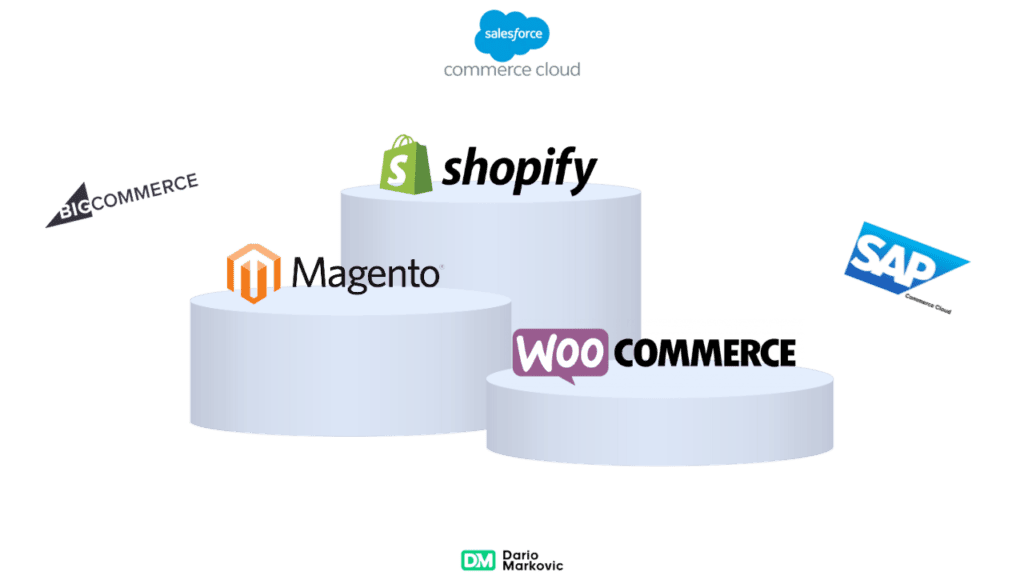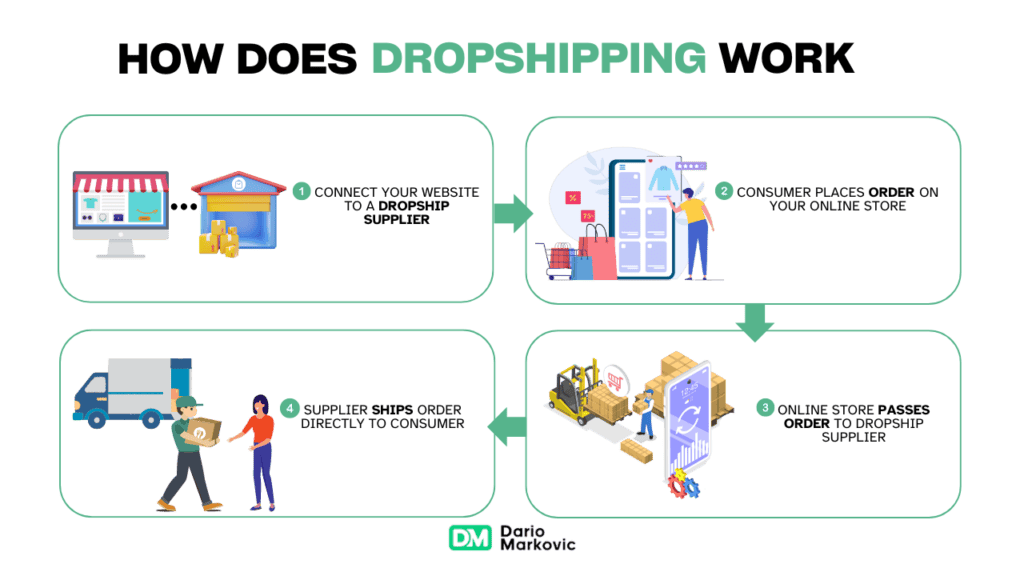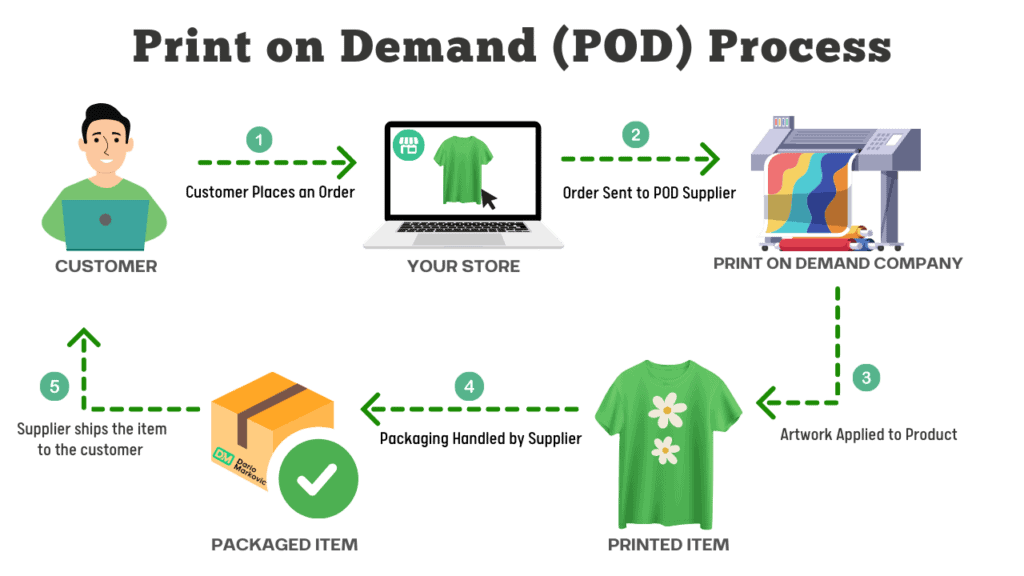In today’s fast-paced world of entrepreneurship, automated business ideas are becoming increasingly popular. These businesses have the ability to generate income with minimal ongoing effort, making them an attractive option for many.
By using technology to their advantage, automated businesses are able to streamline operations, reduce costs, and operate around the clock. This means that even when you’re not actively working on your business, it’s still generating income.
In this article, we have compiled a list of the 33 best automated business ideas. These are ideas that you can start with minimal effort but have great potential for success.
Whether you’re looking to start a side hustle or a full-time venture, these automated business ideas could be just what you need.

How Can These Automated Business Ideas Help You Build Your Own Business?
Automation is the backbone of many successful passive income streams. By leveraging technology, you can create systems that operate independently of your direct involvement.
Here’s how automation works and the benefits it brings:
How Automation Works
Automation involves using software tools and technologies to perform tasks that would otherwise require human intervention.
This includes:
- Automated Marketing: Tools like email marketing platforms can schedule and send emails to your audience without manual input.
- Order Fulfillment: E-commerce solutions such as dropshipping automatically route orders from customers to suppliers.
- Content Creation: AI-powered tools can generate blog posts, social media updates, and even design graphics.
Benefits of Automation
Adopting automated business models offers several advantages:
- Time Efficiency: Automation handles repetitive tasks, freeing up your time for strategic planning or personal activities.
- Scalability: Once set up, automated systems can manage increased workloads without additional effort. This allows you to grow your business smoothly.
- Cost Reduction: By minimizing the need for manual labor, automation reduces operating costs. For instance, chatbots can manage customer service queries without human agents.
- Consistency: Automated processes ensure consistent performance, reducing errors common in manual operations.
Implementing these automated business ideas can transform how you operate, making your income streams more reliable and less dependent on active involvement.
What is Passive Income?
Passive income refers to earnings derived from activities in which you are not actively involved on a day-to-day basis. Unlike traditional income sources, where you trade time for money, passive income streams allow you to earn continuously without constant effort.
The Power of Passive Income
The allure of passive income lies in its potential to create financial freedom and stability.
Here’s how:
- Scalability: Once set up, passive income streams can grow with minimal additional investment.
- Time Freedom: With automated processes in place, you can focus on other pursuits or simply enjoy more leisure time.
- Multiple Streams: Diversifying your income sources reduces risk and increases overall financial security.
Key Characteristics of Passive Income
To understand passive income better, recognize these key traits:
- Minimal Ongoing Effort: After the initial setup, these businesses require little to no daily involvement.
- Recurring Revenue: Successful passive income models generate continuous revenue without frequent intervention.
- Automation Friendly: Technology plays a crucial role, from automating sales processes to managing customer interactions.
By leveraging the power of technology and smart business models, you can create robust passive income streams that work for you around the clock.
Discover The Best Automated Business Ideas Here
Exploring automated business ideas can open up a world of opportunities for aspiring entrepreneurs. These ventures leverage technology to minimize manual effort and maximize efficiency, making it easier to scale your operations.
Whether you’re looking to create passive income streams or streamline existing processes, these ideas offer vast potential.
Consider the following list of automated business ideas:
1. Affiliate Marketing
Affiliate marketing is a widely embraced business model that allows you to earn passive income by promoting other people’s products or services. This method has gained substantial popularity among entrepreneurs due to its minimal startup costs and the potential for high returns.
How Affiliate Marketing Works:
Join an Affiliate Program:
Sign up with companies or networks offering affiliate programs, such as Amazon Associates, ShareASale, or ClickBank.
After joining, you’ll receive unique affiliate links to use in your promotions.
Promote Products or Services:
Use various channels like blogs, social media, or email marketing to share these affiliate links.
Create content that highlights the benefits and features of the products or services you’re promoting.
Earn Commissions:
When someone clicks on your affiliate link and makes a purchase, you earn a commission.
Commissions vary widely depending on the affiliate program and the type of product or service.

Why it Works Well for Beginners
Affiliate marketing stands out as an ideal starting point for beginners in the entrepreneurial realm. Here’s why:
1. Low Initial Investment
Unlike traditional businesses, affiliate marketing doesn’t require substantial capital to get started. You don’t need to invest in inventory, production, or shipping.
2. Simplicity and Flexibility
The core of affiliate marketing revolves around promoting products or services of other companies and earning commissions on sales generated through your referral links. This model allows you to work from anywhere, at any time.
3. Access to Established Products
By partnering with established brands, you can leverage their reputation and customer base without building your own from scratch. This can lead to quicker sales and faster returns on your efforts.
4. Diverse Income Streams
You have the flexibility to promote a variety of products across different niches, diversifying your income streams. This reduces risk since you’re not dependent on a single product or market.
5. Scalability
As you gain experience and understand what works best for your audience, scaling your efforts becomes more manageable. You can expand by promoting more products or exploring new niches.
6. Support and Resources
Many affiliate programs offer extensive resources like training materials, promotional tools, and dedicated support teams to help you succeed.
Strategies for Success
To build a successful affiliate marketing strategy:
- Choose the Right Niche: Focus on areas that interest you and have high demand but low competition.
- Promote Relevant Products: Ensure the products align with your audience’s needs and preferences.
- Provide Value: Create valuable content that educates or entertains your audience while naturally incorporating affiliate links.
- Track Your Performance: Use analytics tools to monitor which strategies are working and adjust accordingly.
Understanding how affiliate marketing works reveals its potential for generating significant income with minimal risk and effort. By building a successful strategy, you can maximize affiliate marketing commissions while enjoying the flexibility of this business model.
2. Creating and Selling E-Books Online
Creating and selling e-books online offers a lucrative avenue for generating passive income with low overhead costs. Leveraging the affiliate marketing business model can further amplify your earnings by promoting your e-books through various channels.

How it Works?
To create and sell e-books online, start by choosing a niche or topic that has a demand and aligns with your expertise.
Write and design your e-book, ensuring it is well-structured, error-free, and visually appealing.
Publish your e-book on popular platforms like Amazon KDP, Apple Books, or your own website, and set a competitive price.
Market your e-book through social media, email lists, and paid advertising to reach a broader audience. Finally, monitor sales, gather feedback, and adjust your strategies to maximize success.
Why it Works Well for Beginners?
Digital products, such as e-books, offer an excellent entry point for beginners looking to dive into the world of automated business models.
Here’s why:
1. Low Initial Investment
Creating digital products requires minimal upfront costs. You can write an e-book or develop an online course with just a computer and an internet connection. This makes it accessible for anyone, regardless of their financial situation.
2. Scalability
Digital products can be sold to an unlimited number of customers without additional production costs. Once you’ve created your e-book or course, you can sell it repeatedly without incurring extra expenses.
3. Automation Potential
By leveraging platforms like Amazon Kindle Direct Publishing (KDP) for e-books or Teachable for online courses, you can automate the entire sales process. These platforms handle everything from payment processing to content delivery, freeing up your time to focus on marketing and content creation.
4. Global Reach
The internet provides a global marketplace for your digital products. Whether you’re selling an e-book on productivity or a course on graphic design, you can reach customers from all corners of the world.
Strategies for Success
Digital information products, such as e-books and online courses, offer significant potential as an automated business idea for beginners.
These products have low production costs, can be distributed globally, and provide a scalable income stream. To succeed in this space, consider the following strategies:
- Identify Your Niche: Focus on a specific topic or area where you have expertise. This helps you target a well-defined audience and reduces competition.
- Market Research: Understand your target audience’s needs and preferences. Use tools like Google Trends, social media polls, and forums to gather insights.
- Content Quality: High-quality content is crucial. Ensure your e-book or course provides valuable information that solves real problems for your audience.
3. E-Commerce Platforms
E-commerce platforms provide a solid foundation for starting your own online store, allowing you to sell products directly to consumers. These platforms come equipped with tools that make it easy to manage inventory, process payments, and track orders.
Popular E-commerce Platforms:
- Shopify: Known for its robust features and extensive app ecosystem, Shopify is ideal for entrepreneurs looking to scale their businesses quickly.
- WooCommerce: A WordPress plugin that transforms your site into a fully functional ecommerce store. It’s highly customizable and integrates well with various plugins.
- BigCommerce: Offers advanced SEO capabilities and multi-channel selling options, making it an excellent choice for larger enterprises.
Leveraging an e-commerce platform allows you to automate many aspects of the affiliate marketing business model, freeing up time to focus on growth strategies. The seamless integration of various tools within these platforms ensures efficient management of your online operations.

4. E-commerce Dropshipping
Dropshipping is a retail fulfillment method where you don’t keep the products you sell in stock. Instead, when you sell a product, you purchase the item from a third party and have it shipped directly to the customer.
How Dropshipping Works
- Set Up an Online Store: Create a website or use platforms like Shopify.
- Choose Products: Select products from suppliers that you want to sell in your store.
- List Products: Add these products to your online store with markups for profit.
- Receive Orders: When customers make purchases, their orders are forwarded to the suppliers.
- Suppliers Ship Products: The suppliers handle shipping and logistics, delivering products directly to your customers.

Why it Works Well for Beginners
Dropshipping is an attractive option for beginners due to its simplicity and low upfront costs. You don’t need to invest in inventory, which reduces financial risk.
This model allows you to focus on marketing and customer service, rather than warehousing and shipping.
Strategies for Success
To excel in dropshipping, focus on these key strategies:
- Niche Selection: Identify a specific market segment. A well-defined niche reduces competition and targets a dedicated customer base.
- Supplier Relationships: Build strong relationships with reliable suppliers. Consistency in product quality and shipping times is crucial.
- Website Optimization: Ensure your e-commerce site is user-friendly, mobile-optimized, and fast-loading. Tools like Shopify make this process easier.
- Effective Marketing: Utilize social media ads, SEO, and email marketing to reach your target audience. Platforms like Facebook Ads can drive significant traffic.
- Customer Service: Provide exceptional customer support to build trust and loyalty. Automated chatbots can handle basic inquiries efficiently.
- Analytics: Regularly analyze sales data and website metrics to understand what works best and where improvements are needed.
These strategies help streamline operations, enhance customer satisfaction, and ultimately boost profitability in the dropshipping model.
5. Email Marketing Automation
Offer marketing and email services through ecommerce marketing automation software to design and distribute targeted email marketing campaigns. By using this method, you can design and schedule specific email campaigns that target certain audiences at the right time.
How It Works:

For example, if you’re promoting health supplements through an affiliate program, an automated sequence might include:
- A welcome email introducing the benefits of the product.
- Follow-up emails sharing customer testimonials and special offers.
- Weekly newsletters with health tips and related product recommendations.
Implementing email marketing automation can significantly increase conversion rates and generate steady passive income.
Why it Works Well for Beginners?
Email marketing automation is beginner-friendly because it offers easy-to-use platforms with pre-designed templates and automated workflows, minimizing the need for technical skills.
It’s cost-effective, with low initial investment and high ROI, making it accessible for small businesses. Automation allows for personalized and segmented content, improving engagement without requiring manual effort.
The “set and forget” nature of automation saves time, enabling beginners to focus on strategy. Lastly, robust analytics provide valuable insights, helping beginners optimize their campaigns based on data-driven decisions.
Strategies for Success
To succeed with email marketing automation, start by setting clear goals and understanding your audience through segmentation and buyer personas. Craft compelling, personalized content with engaging subject lines and clear CTAs. Leverage automation triggers for actions like welcome emails and re-engagement campaigns.
Regularly test different email elements and optimize based on performance analytics. Ensure compliance with regulations like GDPR and maintain a clean email list for optimal deliverability.
6. Social Media Management
The Role of Social Media Managers
Social media managers play a crucial role in the modern digital landscape. They are responsible for developing and implementing strategies to engage with audiences, increase brand awareness, and drive traffic to websites.
Key tasks include:
- Content Creation: Crafting engaging posts, images, and videos that resonate with the target audience.
- Scheduling and Posting: Utilizing tools like Hootsuite or Buffer to plan and publish posts at optimal times.
- Analytics and Reporting: Monitoring performance metrics to refine strategies and achieve better results.
- Community Engagement: Responding to comments, messages, and mentions to foster a loyal community.
Why it Works Well for Beginners?
Social media management works well for beginners because it offers a low barrier to entry with minimal startup costs and user-friendly tools. Platforms like Facebook, Instagram, and Twitter have intuitive interfaces that are easy to navigate and learn.
It allows beginners to build skills in content creation, audience engagement, and analytics through hands-on experience. Many resources, such as online courses and tutorials, are readily available to help newcomers get started.
Additionally, social media’s real-time feedback loop enables beginners to quickly gauge what works and refine their strategies.
Tips for Success
Achieving success in social media management requires a combination of creativity, analytical skills, and strategic thinking.
Here are some tips:
- Know Your Audience: Understand the demographics, interests, and behaviors of your followers to tailor content that meets their needs.
- Consistency is Key: Regular posting helps maintain engagement. Create a content calendar to stay organized.
- Leverage Automation Tools: Tools like Sprout Social can automate repetitive tasks, allowing more time for strategy development.
- Stay Updated on Trends: Social media trends evolve rapidly. Follow industry news to keep your strategies fresh and relevant.
- Engage Authentically: Authentic interactions build trust. Personalize responses and show genuine interest in your community.
Effective social media management can significantly enhance your online presence, driving traffic and conversions for your business ventures.
7. Print-on-Demand Shop
Print-on-demand (POD) services offer a unique opportunity for generating passive income by selling custom products without the need to maintain inventory. When an order is placed, the item is printed and shipped directly to the customer, making it a low-risk business model.
To delve deeper into this business model, you can explore resources like this comprehensive guide on starting a print-on-demand business.
How It Works:

Why it Works Well for Beginners
Print-on-demand is an attractive option for beginners due to its low barrier to entry and minimal risk. You don’t need to invest in inventory upfront, which significantly reduces your initial costs.
This automation business model allows you to start small and scale as your business grows.
Strategies for Success
Print-on-demand (POD) offers a straightforward entry into the world of e-commerce. By allowing you to design custom merchandise that is only produced and shipped after a sale is made, POD eliminates the need for inventory management.
This reduces upfront costs and minimizes financial risk.
8. Virtual Assistance
Virtual assistance offers a flexible and scalable business model that leverages automation tools to handle various administrative tasks. By utilizing software for scheduling, email management, and data entry, you can streamline operations and focus on higher-value activities.
How to Get Started with Virtual Assistant Services
For those interested in integrating virtual assistants into their business operations:
- Identify Tasks to Delegate: Determine which tasks consume most of your time but do not require your direct involvement.
- Find Reputable VA Providers: Platforms like Upwork, Fiverr, and dedicated VA agencies offer access to skilled professionals.
- Create Clear Job Descriptions: Outline specific responsibilities and expectations to ensure alignment.
- Implement Effective Communication Tools: Utilize tools like Slack, Zoom, and Trello to maintain seamless communication and project management.
By incorporating virtual assistant services into your workflow, you can enhance efficiency and focus on scaling your business effectively.
As part of our 33 Best Automated Business Ideas: Explore Automation guide, virtual assistant services stand out for their ability to provide consistent support while allowing entrepreneurs to optimize their time and resources.
Why it Works Well for Beginners
- Low Overhead Costs: Starting a virtual assistance business requires minimal investment. Basic tools like a computer, internet connection, and software subscriptions are sufficient.
- High Demand: Businesses of all sizes need administrative support. Entrepreneurs, small business owners, and even large corporations hire virtual assistants to manage daily tasks efficiently.
- Scalability: Automation tools allow you to handle multiple clients simultaneously without compromising quality. Tools like Trello for project management or Calendly for scheduling automate routine tasks.
Strategies for Success
- CRM Software: Keeps track of client interactions and helps manage relationships effectively.
- Email Marketing Automation: Automates follow-ups and nurtures leads without manual intervention.
- Project Management Tools: Platforms like Asana or Monday.com help in organizing and tracking tasks.
Success in this field often depends on your ability to offer specialized services tailored to specific industries. For instance, an affiliate marketing business model could benefit from virtual assistants skilled in managing affiliate links and campaigns. This specialization not only sets you apart but also allows you to command higher rates for your expertise.
Virtual assistance is an excellent way to generate passive income while maintaining the flexibility to scale your operations as demand grows.
9. Designing Profitable Online Courses
The rise of technology and changing consumer preferences have led to an explosion in the demand for online courses. People seek flexible, accessible learning options that fit into their busy lives, making this a lucrative area for entrepreneurs.
Where to Create Online Course?
Creating an online course platform has become increasingly viable due to technological advancements.
By leveraging the growing trend towards digital education, you can build a sustainable business that meets the needs of modern learners.
- Udemy: Offers a wide variety of courses across different subjects.
- Coursera: Partners with universities and organizations for more academic-focused content.
- Skillshare: Focuses on creative skills with a subscription-based model.
Why it Works Well for Beginners
- Scalability: Once created, a course can serve unlimited students without additional effort.
- Low Overhead Costs: Unlike traditional education, online courses require minimal physical infrastructure.
- Global Reach: The internet allows you to reach a worldwide audience, expanding your market potential.
- Passive Income: After the initial creation and launch phase, online courses can generate ongoing revenue with little upkeep.
Key Steps for Success
To successfully create and market an online course, first identify your niche by focusing on your expertise or areas with high demand and use keyword research tools to find popular topics.
Next, produce high-quality content with professional video production and engaging materials that offer real value. Choose the right platform for your course, such as Teachable, Udemy, or Thinkific, and evaluate their features, fees, and audience reach.
Promote your course through social media, SEO, and email marketing, and consider offering free trials or discounts to attract users.
Finally, gather feedback from students and regularly update your course to maintain its relevance and value.
10. Search Engine Optimization (SEO)
Search Engine Optimization (SEO) is a powerful automated business idea that involves optimizing websites to rank higher on search engine results pages (SERPs). By improving visibility, businesses can attract organic traffic, leading to increased sales and revenue.

If you’re committed to improving your SEO strategy, I highly encourage you to check out Vedran Markovic’s blog. His posts are a valuable resource for anyone looking to gain a competitive edge in the digital landscape.
Why Invest in SEO?
Here are some reasons why investing in SEO is a smart move:
- High Demand: Every business with an online presence needs SEO to remain competitive.
- Scalability: As you develop expertise, you can handle multiple clients simultaneously using SEO tools.
- Passive Income Potential: Once an optimized site starts ranking well, it continues attracting visitors with minimal ongoing effort.
Getting Started
If you’re interested in starting your own SEO business, here are some steps you can take:
- Learn the Basics: Understand the fundamentals of SEO through online courses or tutorials.
- Choose the Right Tools: Select software that fits your business needs and budget.
- Start Small: Begin by offering services to local businesses or personal projects.
Investing in SEO can transform your entrepreneurial journey by generating consistent, passive income through enhanced online visibility.
Strategies for Success
To succeed in SEO, you need to focus on these key components:
- Keyword Research: Identifying words and phrases that potential customers are searching for.
- On-Page Optimization: Enhancing individual web pages to make them more search engine-friendly.
- Off-Page Optimization: Building backlinks from other reputable sites to boost credibility.
- Content Creation: Developing high-quality, relevant content that answers users’ queries.
11. Domain Reselling
Getting the content placed in front of the correct target audience isn’t easy.
Use content syndication, a method to streamline distribution of content across multiple platforms and channels. By distributing your content, you will be able to reach a larger public, increase visitors to your site, and boost your brand’s exposure and credibility in your field.
Read on to understand the best content syndication platforms.
How to Find Valuable Domains?
To succeed in domain reselling, focus on these key tips:
- Research Trends: Stay updated on current trends and popular keywords. Domains related to emerging industries or trending topics can be highly profitable.
- Short and Memorable Names: Short, catchy, and easy-to-remember domain names are more likely to attract buyers.
- Check Domain History: Use tools like WHOIS to check the history of a domain name to ensure it hasn’t been blacklisted or associated with any negative activities.
- Avoid Trademark Issues: Steer clear of domains that might infringe on trademarks to avoid legal complications.
Why it Works Well for Beginners
Domain reselling can be a great entry point for beginners looking to start a business or investment venture.
Here’s why it works well for newcomers:
1. Low Startup Costs: Buying and selling domain names usually requires minimal upfront investment compared to other businesses. You can start with a modest budget, purchasing domains for relatively low prices and reselling them for a profit.
2. Simple Business Model: The process of domain reselling is straightforward. It involves buying domains that you believe will be valuable in the future and selling them at a higher price. This simplicity makes it accessible for beginners who might be overwhelmed by more complex business models.
3. Minimal Overhead: Running a domain reselling business doesn’t require physical inventory or significant overhead costs. Most of your activities will be online, and you won’t need a physical location, which keeps costs low.
4. Flexibility: Domain reselling offers flexibility in terms of time and effort. You can manage it as a side hustle or full-time endeavor, depending on your availability and interest.
5. Scalability: As you gain experience, you can scale up your efforts. You might start with a few domains and gradually expand your portfolio, utilizing strategies like SEO, market research, and domain auctions to maximize profits.
6. Learning Opportunities: Engaging in domain reselling provides valuable experience in online marketing, negotiation, and market trends. These skills can be transferable to other areas of business or investment.
7. Low Risk: Domains are generally low-risk assets. Even if a domain doesn’t sell for a high price, you can hold onto it or try different strategies without incurring significant losses.
8. Global Market: The internet provides a global marketplace for domain names. This means you can reach potential buyers from around the world, increasing your chances of making sales.
For beginners, focusing on finding valuable domain names, understanding market trends, and learning the basics of domain valuation can set a solid foundation for success in domain reselling.
Strategies for Success
A strategic approach can enhance your success in domain reselling:
- Purchase Multiple Domains: Increase your chances of owning a highly sought-after domain by investing in multiple options.
- Hold vs. Flip: Decide whether you want to hold onto domains until they gain significant value or flip them quickly for smaller profits.
- Use Auctions and Marketplaces: Platforms like GoDaddy Auctions, Flippa, and Sedo provide opportunities to buy and sell domains effectively.
12. Content Strategist
A content strategist uses automation tools to make the process of creating, publishing, and managing digital content more efficient.
Their main responsibility is to come up with a comprehensive plan for establishing an online presence that aligns with the goals of the business.

Key Responsibilities
- Content Planning: Use tools like Trello or Asana to organize content ideas, assign tasks, and set deadlines.
- SEO Optimization: Implement automated SEO tools such as Yoast or SEMrush to enhance content visibility.
- Content Scheduling: Use platforms like Buffer or Hootsuite to automate social media postings and maintain consistent engagement.
- Analytics Tracking: Monitor performance through Google Analytics or similar tools to refine strategies based on data-driven insights.
Advantages of Being a Content Strategist:
- Scalability: Automation allows you to handle multiple clients without compromising quality.
- Efficiency: Automating repetitive tasks frees up time for creative and strategic planning.
- Data-Driven Decisions: Access to real-time analytics enables informed decision-making.
Steps to Get Started
Becoming a content strategist can yield substantial rewards by combining creativity with technology-driven efficiency.
- Skill Development: Enroll in courses on platforms like Coursera or Udemy to learn about content strategy and automation tools.
- Tool Selection: Choose the right mix of software for task management, SEO, scheduling, and analytics.
- Build a Portfolio: Create sample work or offer services at a discounted rate initially to build credibility.
- Network: Join industry forums and attend webinars to stay updated and connect with potential clients.
13. Content Writing
Content writing is a versatile business idea that can be easily automated to generate passive income. By creating high-quality written content on various topics, you can attract a steady stream of visitors to your website or blog, monetizing through ads, affiliate links, and sponsored posts.
Why Content Writing?
- Scalability: Once published, content can generate traffic and revenue indefinitely.
- Low Overhead: Minimal initial investment is required, making it accessible for beginners.
- Diverse Monetization: Options include ad revenue, affiliate marketing, and sponsored content.
Steps to Get Started
- Niche Selection: Choose a specific area of expertise or interest.
- Content Creation: Write engaging articles that provide value to readers.
- SEO Optimization: Use SEO techniques to improve search engine rankings.
- Monetization Strategy: Implement ads, affiliate links, or offer sponsored posts.
Strategies for Success
By leveraging these tools and strategies, you can turn content writing into a profitable automated business model.
14. Start a Subscription Box
Subscription box services operate on a recurring revenue model, delivering curated products to customers on a regular basis, typically monthly. These services have gained immense popularity due to their convenience, personalized experience, and the excitement of discovering new products.

Concept Behind Subscription Box Services
The core idea is simple: subscribers receive a box filled with items centered around a particular theme or interest.
This model appeals to consumers for several reasons:
- Convenience: Products are delivered directly to their doorstep.
- Personalization: Boxes are often tailored to individual preferences.
- Discovery: Customers enjoy the surprise element and the chance to try new products.
Some popular niches for subscription boxes include beauty products, snacks, fitness gear, books, and pet supplies.
Why They Stand Out
Subscription boxes thrive because they provide consistent value and foster customer loyalty through regular engagement. The recurring revenue model ensures predictable income while the automated systems handle logistics efficiently.
Strategies for Success
Identify Your Niche:
- Focus on a specific interest or problem that your box will solve.
- Conduct market research to ensure there is demand.
Source Products:
- Partner with manufacturers or wholesalers for bulk purchasing.
- Ensure high-quality items that align with your brand values.
Design Your Box:
- Create appealing packaging that enhances the unboxing experience.
- Include branding elements such as logos and unique designs.
Build an Online Presence:
- Develop a user-friendly website with clear subscription options.
- Use social media and email marketing to reach potential customers.
Implement Automation Tools:
- Utilize automated billing systems for recurring payments.
- Employ inventory management software to track stock levels and shipments.
Launch and Scale:
- Offer promotional discounts or initial trial boxes to attract subscribers.
- Gather feedback from customers and continuously improve your offerings.
15. Launch a Podcast
Creating a podcast is an excellent way to share your expertise and connect with a broader audience. This automated business idea leverages the power of audio content to engage listeners, build brand loyalty, and generate revenue through various monetization strategies.
The amount of Americans listening to podcasts will increase between 2024 and 2029 by in total 37.2 million users (+48.7 percent).
Monetizeation Strategies for Podcast
- Sponsorships: Partner with brands that align with your niche to feature ads within your episodes.
- Affiliate Marketing: Promote products or services relevant to your audience and earn commissions on sales through referral links.
- Merchandising: Sell branded merchandise related to your podcast to loyal listeners.
- Crowdfunding: Use platforms like Patreon to offer exclusive content and perks to subscribers who support you financially.

Why it Works Well for Beginners
- Low Startup Costs: Compared to other business models, launching a podcast requires minimal initial investment.
- Scalability: As your listener base grows, so do your opportunities for monetization.
- Flexibility: Podcasts can be recorded and edited on your own schedule, offering flexibility in managing time.
Podcasting provides a unique platform for sharing valuable content, building an engaged community, and creating multiple streams of income through automation.
Steps to Get Started
- Choose Your Niche: Identify a specific topic or area of interest that you are passionate about and have knowledge in.
- Plan Your Content: Outline episodes, plan interviews, and create a content calendar to stay organized.
- Set Up Equipment: Invest in quality recording equipment such as microphones, headphones, and editing software.
- Record & Edit: Record your episodes, edit them for clarity, and add any necessary sound effects or music.
- Publish: Use podcast hosting platforms like Anchor, Libsyn, or Podbean to distribute your episodes across major podcast directories.
16. Become an Influencer

Influencer marketing, estimated at around $21 billion by Statista, is a vast business opportunity. While many associate influencers with celebrities, there’s a thriving market for micro-influencers–individuals with smaller yet engaged followings.
Why is it essential to pursue the status of an influencer?
- It is a great way to learn marketing.
- It is useful when you want to enter the field professionally.
- You’ll find new and exciting brands and discover companies and products you genuinely enjoy through collaborations.
- It allows you to build your brand.
How It Works
- Content Creation: Regularly post engaging content that resonates with your audience.
- Brand Collaborations: Partner with brands to promote their products or services.
- Affiliate Marketing: Share referral links to earn commissions on sales.
- Sponsored Posts: Get paid to create posts featuring specific products or services.
Why it Works Well for Beginners
- Low Startup Costs: Requires minimal investment beyond a smartphone and internet connection.
- Flexibility: Create content on your own schedule and from any location.
- Multiple Revenue Streams: Earn money through ads, sponsorships, affiliate marketing, and more.
Steps for Success
- Choose Your Niche: Focus on a specific area of interest or expertise.
- Create Quality Content: Invest in good equipment and editing tools.
- Engage with Followers: Respond to comments and messages to build a community.
- Collaborate with Brands: Reach out to brands for partnerships once you have a substantial following.
Becoming an influencer offers the potential for passive income through business automation tools like scheduling apps and analytics platforms. The key is to remain authentic and consistent in your content creation efforts.
17. Online Coaching
Creating and selling online courses can be a highly profitable and automated business ideas venture. The e-learning industry continues to expand rapidly, driven by the increasing demand for flexible learning options.
Offering Virtual Services
Online coaching provides a flexible and scalable way to offer your expertise to a global audience. You can conduct sessions over video calls, webinars, or through specialized coaching platforms.
This method allows you to manage multiple clients without geographical constraints, making it an excellent option for those looking to maximize their reach with minimal overhead.
Why It’s Great for Beginners
If you’re not particularly tech-savvy, online coaching is a great entry point into the digital business world. Unlike more complex automated business ideas like affiliate marketing or SaaS solutions, online coaching primarily requires strong communication skills and domain expertise.
Platforms such as Zoom, Skype, and Google Meet are user-friendly and widely accessible, helping you easily connect with clients.
Strategies for Success
- Niche Selection: Specialize in a specific area where you have significant expertise. This could be anything from business coaching to personal development.
- Marketing Your Services: Utilize social media platforms and SEO techniques to drive traffic to your coaching website or profile.
- Continuous Learning: Stay updated with the latest trends and best practices in your field by enrolling in online courses.
- Client Testimonials: Collect and showcase positive reviews from satisfied clients to build credibility and attract new customers.
Online coaching offers an appealing blend of flexibility and profitability, making it a viable passive income stream for many professionals.
18. Chatbots for Customer Service
Chatbots have changed the way businesses communicate with their customers. Using AI technology, chatbots make customer service more efficient and improve the overall user experience
How Chatbots Improve Customer Service
1. Always Available: Chatbots are available 24/7, ensuring that customers receive immediate responses at any time. This leads to happier customers and better retention rates.
2. Quick Resolution of Queries: By handling simple and repetitive questions, chatbots allow human agents to focus on more complicated issues. This helps reduce waiting times and improves overall efficiency.
3. Personalized Interactions: Advanced AI chatbots can analyze customer data to offer personalized recommendations and solutions, making the user experience even better.
4. Consistent Responses: Uniform responses eliminate the risk of human error and provide consistent information to all customers, which is crucial for maintaining brand integrity.
Why It’s Great for Your Customer Service
- 24/7 Availability: Chatbots ensure uninterrupted service, enhancing customer satisfaction.
- Cost-Effective: Reduces the need for hiring full-time customer support staff.
- Scalability: Easily handle multiple queries simultaneously without compromising quality.
Strategies for Success with Chatbot Services:
- Identify a Niche: Focus on specific industries such as e-commerce, healthcare, or finance where chatbot integration can significantly improve customer interaction.
- Choose a Platform: Use platforms like Dialogflow, Microsoft Bot Framework, or Chatfuel to build and deploy your chatbot.
- Develop and Test: Create a chatbot that effectively addresses common customer queries and test it rigorously to ensure reliability.
- Market Your Service: Promote your chatbot solutions through targeted marketing campaigns and affiliate marketing business models to attract potential clients.
By automating repetitive tasks and providing immediate responses to customer inquiries, chatbots enhance user experience while reducing operational costs. This makes them an attractive option for businesses looking to streamline their operations and improve customer engagement.
19. Vending Machines
Vending machines are automated devices that dispense products like snacks and drinks when users insert money or a payment card. After selecting an item and completing the payment, the machine releases the product through a mechanical mechanism.
They offer a convenient way to purchase goods quickly and without needing human interaction.
How it Works?
The vending machine automated business idea involves selecting a product niche, acquiring suitable vending machines, and placing them in high-traffic locations to maximize sales.
Machines should be stocked regularly and maintained to ensure proper operation. Sales and inventory are monitored using software to optimize performance and restocking.
Why it Works Well for Beginners
Starting a vending machine business offers several advantages for beginners:
- Low Initial Investment: Compared to other businesses, vending machines require a relatively small upfront investment.
- Scalability: You can start with just one or two machines and gradually scale up as you reinvest profits.
- Minimal Time Commitment: Once machines are placed and stocked, they require minimal time to operate, allowing you to focus on other ventures or maintain a day job.
- Passive Income Potential: Vending machines generate income continuously without requiring constant oversight.
Strategies for Success
Implementing effective strategies can significantly boost your chances of success in the vending machine business:
- Market Research: Conduct thorough market research to identify high-demand products in your target locations.
- Location Contracts: Negotiate favorable contracts with property owners for prime locations with high visibility and foot traffic.
- Diverse Product Offering: Offer a variety of products to cater to different preferences and increase sales potential.
- Regular Maintenance: Ensure machines are always clean, functional, and well-stocked to maintain customer satisfaction.
- Leverage Technology: Utilize smart vending machines with remote monitoring capabilities to streamline operations and reduce downtime.
By following these guidelines, you can create a profitable vending machine business that runs efficiently with minimal hands-on management.
20. Automated Dropshipping Platform
An automated dropshipping platform streamlines the entire e-commerce process, making it an attractive option for entrepreneurs looking to minimize hands-on management.
These platforms like Oberlo integrate with suppliers, manage inventory, and handle order fulfillment automatically.
What is the Offer?
Automated dropshipping platforms offer a simplified approach to running an e-commerce business, enabling you to focus on marketing and customer engagement while the backend operations run smoothly.
- Supplier Integration: Connects directly with suppliers to update product listings and stock levels in real-time.
- Order Management: Automates the process of forwarding orders to suppliers for fulfillment.
- Inventory Tracking: Keeps track of stock levels and automatically removes out-of-stock items from your store.
- Pricing Automation: Adjusts prices based on predefined rules or market trends.
Why it Works Well for Beginners
- Low Overhead Costs: You don’t need to invest in inventory upfront, significantly reducing financial risks.
- Scalability: Automation tools can handle order processing, inventory updates, and customer service, allowing you to scale your business effortlessly.
- Flexibility: Operate from anywhere, making it ideal for digital nomads or those looking for a side hustle.
Strategies for Success
To succeed with an automated dropshipping platform, choose a platform that aligns with your target market and product niche while establishing reliable and diversified supplier relationships.
Leverage automation for inventory management, pricing strategies, and order processing, allowing you to focus on targeted marketing and customer support. Regularly monitor performance and make data-driven decisions to optimize your store and adapt to changes.
Additionally, manage risks by having backup plans and ensuring legal compliance, while continuously learning and scaling your business by testing new products and expanding into new markets.
21. Start a Blog
Starting a blog can be one of the most rewarding automated business ideas. It allows you to share your knowledge, passions, and expertise on a global scale while generating passive income through various monetization methods.
Why Blogging?
Blogging is an attractive option due to its low initial investment, with free platforms and affordable domain and hosting options. It offers significant scalability, allowing you to grow your audience and income potential over time.
There are multiple income streams available, including affiliate marketing, ad revenue, and sponsored posts.
To get started, choose a niche you are passionate about, set up your blog on a platform like WordPress, create quality content, and explore monetization opportunities as your readership grows.

Why it Works Well for Beginners
Blogging is a popular choice for beginners for several reasons:
1. Low Barrier to Entry: Starting a blog is relatively easy and inexpensive. Many platforms, like WordPress, Medium, or Blogger, offer free or low-cost options to set up a blog. You don’t need advanced technical skills to get started.
2. Creative Expression: Blogging allows beginners to express their ideas, thoughts, and knowledge on various topics. It’s a platform where you can explore your voice and style, making it an ideal starting point for those who are new to writing or content creation.
3. Learning and Growth: Blogging helps beginners learn new skills, such as writing, SEO (Search Engine Optimization), content marketing, and web design. As you continue to blog, you naturally improve your writing, research, and critical thinking skills.
4. Builds an Online Presence: For beginners looking to establish a personal brand or online presence, blogging is a powerful tool. It helps you showcase your expertise and interests, which can lead to networking opportunities, job offers, or collaborations.
5. Monetization Potential: While it may take time, blogging can eventually lead to monetization. Through ads, affiliate marketing, sponsored posts, or selling products/services, beginners can start earning money from their blog as they build an audience.
6. Community Engagement: Blogging allows you to connect with like-minded individuals. Whether through comments, social media, or email, you can engage with readers, receive feedback, and build a community around your blog.
7. Portfolio Development: For beginners in fields like writing, marketing, or journalism, a blog can serve as a portfolio to showcase your work. This is especially valuable when applying for jobs or freelance opportunities.
8. Flexibility and Control: Blogging gives you full control over the content you create. You can choose topics, post frequency, and the overall direction of your blog, allowing for a flexible and personalized experience.
9. Long-Term Impact: Unlike social media posts, blog content can have a long-lasting impact. Well-written blog posts can continue to attract readers and drive traffic for months or even years after being published.
These factors make blogging an accessible and rewarding endeavor for beginners, allowing them to grow and succeed at their own pace.
Strategies for Success
- SEO Optimization: Implement SEO best practices to improve search engine rankings.
- Social Media Promotion: Share your posts on social media platforms to increase visibility.
- Email Marketing: Build an email list to keep your audience engaged with newsletters and updates.
Starting a blog offers both flexibility and the potential for substantial passive income, making it an attractive option for aspiring entrepreneurs.
22. Printable Templates
Printable templates offer a unique opportunity for automation in the creative industry. By designing templates for various needs—such as planners, invitations, resumes, and educational worksheets—you can generate a steady stream of income with minimal ongoing effort.
How it Works?
Printable templates are pre-designed files that customers can purchase, download, and print at home. These templates can range from planners and calendars to invitations and worksheets.
Process of Selling Printable Templates:
- Design Creation: Use graphic design software like Adobe Illustrator or Canva to create visually appealing templates. Ensure your designs cater to specific niches such as wedding planning, educational resources, or business organization.
- Digital Storefront: Set up an online store on platforms like Etsy, Gumroad, or Shopify. Provide high-quality previews of your templates to attract potential buyers.
- Marketing: Utilize social media channels and email marketing to promote your printable templates. Join relevant online communities where potential customers are likely to gather.
- Delivery: Once a customer makes a purchase, they receive a downloadable file instantly or via email. This eliminates the need for physical shipping and handling.
- Customer Support: Offer assistance for any issues related to downloading or printing the templates. Providing clear instructions can minimize support requests.
Why it Works Well for Beginners
- Low Overhead Costs: Creating and selling printable templates require little to no upfront costs beyond design software.
- Scalable Income: Once designed, templates can be sold repeatedly without additional work.
- Broad Market Appeal: From students to professionals, almost everyone can find value in some type of printable template.
Strategies for Success
- Offer Customization: Allowing minor customizations can set your templates apart from competitors.
- Bundle Products: Create themed bundles to increase the perceived value and encourage bulk purchases.
- Utilize SEO: Optimize your listings with relevant keywords to attract more organic traffic.
By focusing on high-demand niches and leveraging platforms that handle sales and distribution, you can build a profitable business around printable templates with ease.
23. Pinterest Virtual Assistant
It’s similar to a typical VA business, but it focuses on helping businesses increase the presence of their business on Pinterest.
In this position, you help build an effective Pinterest marketing plan, develop pinnable visuals, set up boards, schedule daily pins and more.
Kristin Larsen`s blog offers a step-by-step guide curriculum designed to help specialize as a Pinterest Virtual Assistant.
How it Works?
A Pinterest Virtual Assistant (VA) specializes in managing Pinterest accounts for businesses and individuals. Their role involves creating, curating, and scheduling pins, optimizing profiles, conducting keyword research, and driving traffic to websites through Pinterest strategies.
Why it Works Well for Beginners
Starting as a Pinterest VA is accessible for beginners due to its low overhead costs and flexibility.
You don’t need a large initial investment; a stable internet connection and proficiency with graphic design tools are sufficient.
Advantages:
- Low Startup Costs: Minimal investment required for software tools.
- Flexibility: Work can be done remotely, offering flexible hours.
- Growing Demand: Businesses increasingly recognize the value of Pinterest for driving traffic.
Strategies for Success
Success as a Pinterest VA hinges on mastering both creative and analytical skills.
Here are some strategies:
- Invest in Training: Enroll in courses that teach advanced Pinterest marketing techniques.
- Build a Portfolio: Create sample boards to showcase your skills to potential clients.
- Network: Join online communities or forums where business owners seek VAs.
- Use Analytics: Regularly review Pinterest Analytics to measure the performance of your strategies and adjust accordingly.
By focusing on these areas, you can effectively manage Pinterest accounts and deliver tangible results for clients, making it a lucrative automated business idea.
24. AI Enabled Recruiting Platform
An AI-enabled recruiting platform automates the hiring process, making it a lucrative passive income source. With best automation tools, you can streamline candidate sourcing, screening, and selection, reducing manual effort significantly.
How It Works:
AI-enabled recruiting platforms use artificial intelligence to make the hiring process easier and better.
These platforms use machine learning algorithms to analyze large amounts of data, allowing them to:
- Screen Resumes Efficiently: By scanning resumes for specific keywords and qualifications, AI can quickly identify top candidates, reducing the time spent on manual review.
- Match Candidates with Job Descriptions: AI algorithms match candidates’ skills and experiences with job requirements, ensuring a better fit and higher chances of successful hires.
- Automate Communication: AI chatbots handle initial communications with candidates, answering frequently asked questions and scheduling interviews.
- Predict Candidate Success: By analyzing historical hiring data, AI can predict which candidates are likely to succeed in specific roles based on their profiles.
Why it Works Well for Beginners
Starting an AI-enabled recruiting platform has several advantages for those new to entrepreneurship:
- Reduced Manual Labor: Automating resume screening and initial communication saves time and effort, allowing you to focus on strategic aspects of your business.
- Scalability: As your platform grows, the AI system can handle increasing volumes of candidate data without requiring proportional increases in human resources.
- Cost Efficiency: By reducing the need for large HR teams, AI-enabled recruiting platforms cut down operational costs.
Strategies for Success
To implement an AI-enabled recruiting platform successfully, consider these key strategies:
- Invest in Quality AlgorithmsEnsure your AI algorithms are trained on diverse datasets to minimize biases and improve accuracy.
- Enhance User ExperienceDesign an intuitive interface for both employers and job seekers. Ease of use can significantly impact user adoption and satisfaction.
- Focus on Data SecurityProtect candidate information through robust security measures. Ensuring data privacy builds trust with users.
25.Self-Service Car Wash
A Self-Service Car Wash offers customers the flexibility to clean their vehicles at their own pace using provided equipment and cleaning products.
These facilities typically feature high-pressure hoses, vacuum stations, and a variety of soaps and waxes for a customized wash. With affordable pricing and the convenience of doing it yourself, it’s a popular choice for car owners who prefer a hands-on approach to car care.
How to Start?
Starting a self-service car wash can be a lucrative automated business opportunity. Here’s how you can get started:
1. Research and Planning
- Conduct market research to understand the demand for car wash services in your area.
- Identify potential locations with high traffic and accessibility.
- Create a detailed business plan outlining your target market, competition, pricing strategy, and projected expenses.
2. Selecting a Location
- Choose a location that is easily accessible and has sufficient space for multiple washing bays.
- Ensure the site has proper drainage systems and is compliant with local environmental regulations.
3. Investing in Equipment
- Purchase high-quality car wash equipment like pressure washers, foam dispensers, vacuums, and water reclaim systems.
- Consider investing in advanced car wash automation technology to reduce manual intervention and improve efficiency.
4. Setting Up Infrastructure
- Construct washing bays with durable materials that can withstand water and chemical exposure.
- Install necessary plumbing, electrical connections, and lighting to ensure a safe and functional environment.
5. Automation Systems
- Implement payment kiosks that accept cash, credit cards, or mobile payments for hassle-free transactions.
- Use automated soap dispensers, dryers, and water sprayers to minimize the need for manual labor.
- Integrate a tracking system to monitor usage patterns and manage maintenance schedules effectively.
6. Marketing Your Business
- Develop an online presence through social media platforms and local directories.
- Offer promotional deals or loyalty programs to attract and retain customers.
- Collaborate with local businesses such as auto repair shops or gas stations for cross-promotional opportunities.
7. Maintenance and Upkeep
- Schedule regular maintenance checks to ensure all equipment is functioning correctly.
- Keep the facility clean and well-maintained to provide a positive customer experience.
- Address any technical issues promptly to avoid service disruptions.
Why it Works Well for Beginners
Self-service car washes are appealing for several reasons:
- Low Operating Costs: Automation reduces the need for extensive staff, lowering overall operating expenses.
- Scalability: Once established, it’s easy to replicate the business model in different locations.
- Passive Income Potential: With minimal day-to-day involvement required, you can focus on other ventures while generating steady revenue from the car wash.
Strategies for Success
To ensure success in your self-service car wash business:
Focus on Customer Experience: Provide clear instructions on how to use the equipment effectively. Ensure that customer support is available through phone or chat for any queries or issues.
Leverage Technology: Use apps or online booking systems that allow customers to schedule their visits during off-peak hours or avail special services.
Monitor Performance Metrics: Track key performance indicators (KPIs) such as customer satisfaction, repeat visits, and revenue per visit to continually optimize your operations.
Self-service car washes offer an excellent opportunity for entrepreneurs looking to leverage automation technology in their business ventures. By following these steps and strategies, you can establish a successful self-service car wash that operates efficiently with minimal manual intervention.
26. Youtube Automation
Welcome to the Dario Markovic Youtube channel, where you find me in front of the camera – intentionally. This strategy extends to other successful ventures I’ve spearheaded, such as Business Stories Decoded or Alpha Money Income.
YouTube automation offers a unique opportunity to generate passive income through video content without extensive ongoing effort. By leveraging technology and outsourcing, you can create a steady stream of engaging videos that attract viewers and monetize your channel effectively.

How It Works
YouTube automation involves several steps:
- Content Creation: Outsource scriptwriting, voiceovers, and video editing to professionals on platforms like Fiverr or Upwork.
- Scheduling and Uploading: Use tools like TubeBuddy or Hootsuite to schedule and manage your uploads.
- SEO Optimization: Optimize titles, descriptions, and tags using SEO tools to increase visibility.
- Monetization: Enable ads, affiliate links, and sponsored content to earn revenue.
Why it Works Well for Beginners?
- Scalability: Once set up, your channel can continuously grow with minimal intervention.
- Multiple Revenue Streams: Earn from ads, sponsorships, merchandise sales, and more.
- Global Audience Reach: Tap into a vast audience with diverse interests.
Strategies for Success
- Niche Selection: Choose a niche with high demand but low competition.
- Consistency: Maintain a regular posting schedule to keep your audience engaged.
- Analytics: Monitor performance using YouTube Analytics to adjust strategies for better results.
By automating the repetitive tasks associated with running a YouTube channel, you can focus on strategic growth and enjoy the benefits of passive income.
27. Remote IT Support
Remote IT support uses technology to provide technical help and maintenance services to clients without needing to be physically present. This model is highly scalable and can serve clients globally.
How It Works
- Client Communication: Use tools like Zoom, Microsoft Teams, or Slack for real-time communication with clients.
- Remote Access Software: Employ platforms such as TeamViewer or AnyDesk to access and troubleshoot client systems.
- Automation Tools: Utilize scripts and automation software to perform routine tasks like software updates and backups.
Why it Works Well for Beginners?
- Scalability: You can handle multiple clients simultaneously through automation.
- Flexibility: Work from any location, provided you have a stable internet connection.
- Cost-effective: No need for a physical office space, reducing overhead costs.
Strategies for Success
- Specialization: Focus on niche markets such as cybersecurity, data recovery, or cloud services to stand out.
- Customer Service: Provide excellent customer support to build long-term relationships.
- Continuous Learning: Stay updated with the latest technologies and industry trends to offer cutting-edge solutions.
Remote IT support offers a lucrative opportunity for tech-savvy entrepreneurs looking to use their skills in an automated business idea.
28. E-Commerce Consultancy
Provide consultancy services to e-commerce businesses, aiding them in streamlining operations and boosting sales. I have helped Eric Javits from almost bankruptcy to $50 million in sales because I have the expert skill as an e-commerce consultant and know every detail in marketing strategy, how to implement multichannel selling, and how to add new technologies.
Key Services Offered by E-Commerce Consultants
- Website Optimization: Ensuring that the client’s website is user-friendly, fast, and optimized for search engines.
- Digital Marketing Strategies: Crafting tailored marketing campaigns to boost visibility and drive traffic.
- Conversion Rate Optimization: Analyzing customer behavior to improve the sales funnel and increase conversion rates.
- Inventory Management Solutions: Implementing systems to efficiently manage stock levels and streamline supply chains.
- Customer Relationship Management (CRM): Advising on tools and techniques to enhance customer engagement and retention.

Why E-Commerce Consultancy Works Well For Beginners
- High Demand: With the growth of online shopping, businesses are continually seeking ways to improve their e-commerce platforms.
- Scalability: Utilizing automation tools for client management, reporting, and marketing allows consultants to scale their services without additional manpower.
- Expert Positioning: Establishing yourself as an expert through content marketing, such as blog posts or webinars, can attract a steady stream of clients.
Steps to Start Your E-Commerce Consultancy
- Build Your Expertise: Gain experience through hands-on work or certifications in e-commerce platforms like Shopify or WooCommerce.
- Develop a Business Plan: Define your target market, services offered, pricing strategy, and marketing plan.
- Create a Professional Website: Showcase your expertise with case studies, testimonials, and a portfolio of past work.
- Leverage Automation Tools: Use CRM software, email marketing automation, and project management tools to handle repetitive tasks efficiently.
- Network and Market Yourself: Attend industry conferences, join professional groups, and actively engage on social media to build your reputation.
E-commerce consultancy offers a blend of strategic thinking and technical know-how. By automating routine tasks, you can focus on delivering high-value insights that drive your clients’ success while creating a sustainable business model for yourself.
29. Building a Loyal Subscriber Base
Building a loyal subscriber base is crucial for the long-term success of your automated business. Subscribers are individuals who have shown interest in your content, products, or services and have willingly opted in to receive updates from you.
They represent a consistent audience that you can rely on for engagement and revenue.
Why is a Loyal Subscriber Base Important?
- Consistent Audience: Subscribers are more likely to engage with your content and offerings compared to casual visitors. They have already expressed interest in what you have to offer, making them a valuable audience segment.
- Reliable Revenue Stream: Depending on your business model, subscribers can provide a steady stream of income through subscriptions, memberships, or repeat purchases. This predictable revenue can help sustain and grow your business.
- Word-of-Mouth Marketing: A loyal subscriber base can become your brand advocates, spreading the word about your business to their networks. This organic marketing can lead to new customers and increased brand visibility.
Why It’s Great for Beginners
When Investing time as a beginner and put effort into building a loyal subscriber base pays off in the long run:
- Increased Retention Rates: Loyal subscribers are less likely to unsubscribe or stop engaging with your brand compared to casual followers.
- Higher Conversion Rates: When it comes time for them to make a purchase decision or refer someone else, loyal subscribers are more likely to convert based on their positive experiences with your business.
- Sustainable Growth: With a dedicated group of supporters who consistently consume/share/recommend your content/products/services – growth becomes less reliant on paid advertising or external factors.
Remember that building loyalty takes time – but it’s worth it! By focusing on delivering value consistently while nurturing relationships along the way – you’ll create an ecosystem where both parties benefit mutually over time: You get steady income & growth; They get valuable resources & experiences!
Strategies for Successful Loyal Subscriber Base
Here are some effective strategies to cultivate loyalty among your subscribers:
- Deliver Value: Consistently provide valuable content, resources, or offers that resonate with your audience. When subscribers see the benefits of being on your list, they are more likely to remain engaged.
- Personalize Communication: Use segmentation and personalization techniques to tailor your messages to different subscriber groups. Addressing subscribers by name and sending targeted offers can make them feel special and appreciated.
- Engage with Your Audience: Encourage interaction and feedback from your subscribers through surveys, polls, or social media discussions. Actively responding to their queries or comments shows that you value their opinions.
- Offer Exclusive Benefits: Provide exclusive perks such as discounts, early access to new products/services, or members-only content as incentives for subscribers to stay loyal.
30. Photography Print Sales
Photography print sales offer a unique opportunity for photographers to monetize their work. By creating high-quality prints of their photographs, photographers can reach a wide audience interested in purchasing art for personal or commercial use.

Steps to Start Selling Photography Prints
- Build Your Portfolio: Curate your best work into an online portfolio that showcases your unique style and high-resolution images.
- Choose Printing Options: Decide whether you will handle printing yourself or use a third-party print-on-demand service.
- Set Up an Online Store: Platforms like Etsy, Shopify, and Fine Art America allow you to create a professional storefront without extensive technical knowledge.
- Marketing and Promotion: Utilize social media, SEO techniques, and email marketing to drive traffic to your store.
Why It’s Great for Beginners
- Scalability: Once your online store is set up, it requires minimal maintenance. Automated systems handle orders and payments.
- Low Overhead Costs: Using print-on-demand services eliminates the need for inventory, reducing initial investment.
- Creative Freedom: You retain full control over the artistic direction and selection of prints.
Where to Succeed?
Selling photography prints combines creativity with entrepreneurship, allowing you to turn your passion into a profitable business.
- Etsy: Ideal for reaching an audience interested in handmade and unique items.
- Shopify: Offers robust e-commerce tools for managing your online store.
- Fine Art America: Specializes in selling art prints, making it easier to connect with art collectors.
31. Online Craft Store
An online craft store offers a unique and personalized shopping experience by selling handmade or custom products. This business model allows artisans to showcase their creativity while leveraging automation for order processing, inventory management, and shipping.
How to Start?
- Choose a Niche: Focus on a specific category such as jewelry, home decor, or personalized gifts to attract a targeted audience.
- Set Up an Ecommerce Platform: Use platforms like Etsy, Shopify, or WooCommerce that support craft sellers with easy-to-use interfaces and built-in marketing tools.
- Automate Inventory Management: Implement software like TradeGecko or Stitch Labs to keep track of stock levels and reorder supplies automatically.
- Streamline Order Fulfillment: Utilize services like ShipStation or Printful to automate shipping and ensure timely delivery.
Why It’s Great for Beginners
- Personalized Onboarding Experience: Tailored onboarding helps new subscribers feel valued, increasing their likelihood to stay engaged.
- Consistent Value Delivery: Offering high-quality content or products consistently ensures subscribers feel they’re receiving excellent value for their investment.
- Enhanced Engagement: Regular communication through emails, social media, and community forums fosters trust and keeps subscribers connected.
- Incentives for Retention: Loyalty programs and exclusive discounts motivate subscribers to commit long-term.
- Automated Support: Quick, automated customer support enhances the user experience with minimal effort.
- Proactive Feedback: Regular check-ins via surveys help maintain satisfaction and inform necessary service adjustments.
- Transparency and Trust: Honest communication about changes builds trust, ensuring subscribers feel respected and valued.
By focusing on these areas, businesses can not only retain subscribers but also convert them into loyal advocates, driving organic growth through positive word-of-mouth.
Strategies for Success
By harnessing the power of automation, an online craft store can operate efficiently while you focus on creating beautiful, unique items.
- High-Quality Photos: Invest in professional photography to make your products stand out.
- Engage on Social Media: Platforms like Instagram and Pinterest are ideal for crafts, allowing you to build a loyal customer base.
- Offer Customization Options: Personalized products often attract more buyers willing to pay a premium.
32. Handmade Soap and Cosmetics
Handmade soap and cosmetics have gained popularity due to their unique, natural ingredients and artisanal touch. This business idea involves creating custom beauty products, such as soaps, lotions, and bath bombs, which appeal to consumers looking for chemical-free alternatives.
Why Handmade Soap and Cosmetics?
- Unique Selling Proposition (USP): Offering handcrafted products with natural ingredients can differentiate your brand from mass-produced items.
- Customization: You can create products tailored to specific customer needs, like sensitive skin or particular scents.
- Sustainability: Consumers are increasingly looking for eco-friendly options. Handmade products often use sustainable packaging and ethically sourced ingredients.
Why It’s Great for Beginners
- Manufacturing: Use automated tools for mixing and pouring ingredients to streamline production.
- Marketing: Implement email marketing campaigns and social media schedulers to maintain consistent customer engagement.
- Inventory Management: Utilize software to track stock levels, manage orders, and predict future needs.
Offering handmade soap and cosmetics not only allows you to tap into a growing market but also provides opportunities for creativity and innovation in product development.
Strategies for Success
- Research and Development: Experiment with different recipes and ingredients to develop high-quality products.
- Compliance: Ensure your products comply with local regulations regarding cosmetics and personal care items.
- Branding: Develop a strong brand identity that emphasizes the handmade, natural aspects of your products.
- Online Presence: Set up an e-commerce store or use platforms like Etsy to reach a wider audience.
33. Online Personal Styling
Online personal styling uses technology to offer customized fashion advice and handpicked outfit suggestions. These services analyze data to recommend clothing items based on a person’s likes, body shape, and style objectives.
How It Works
- Client Profile Creation: Customers fill out detailed questionnaires about their style preferences, sizing information, and fashion goals.
- Algorithmic Matching: Automated systems analyze the client’s profile to recommend suitable clothing items.
- Personalized Recommendations: Clients receive curated outfit suggestions via email or through a dedicated platform.
- Purchase and Delivery: Customers can purchase the recommended items directly through the service, often benefiting from integrated e-commerce solutions
Why It’s Great for Beginners
- Convenience: Clients receive tailored fashion advice without leaving their homes.
- Personalization: Advanced algorithms ensure that recommendations are highly personalized.
- Scalability: Automated processes allow start-ups and small businesses to serve a large number of clients simultaneously.
Strategies for Success
You can use these AI platforms and machine learning to improve your user experience, making it easier for you to find new styles and trends for your clients.
- Stitch Fix
- Trunk Club
- Thread
Set Clear Expectations
Setting clear expectations is crucial for the success of any automated business model. When you know what to expect, it becomes easier to plan effectively and manage your resources.
Here’s why setting clear expectations matters:
- Goal Alignment: Clearly defined goals help align your efforts with your desired outcomes. This ensures that every action you take contributes to achieving those goals.
- Resource Management: Understanding the time, money, and effort required allows you to allocate resources more efficiently. This prevents overspending and underestimating the work involved.
- Performance Measurement: Setting benchmarks enables you to measure performance accurately. It helps in identifying what’s working and what needs improvement.
Examples of clear expectations include:
- Time Commitment: Knowing how much time you need to invest initially and ongoing can help avoid burnout.
- Financial Investment: Having a clear idea of the financial investment required helps in budgeting and financial planning.
- Return on Investment (ROI): Understanding potential earnings and how long it might take to see profits ensures realistic financial expectations.
Setting these expectations early on provides a roadmap for your automated business venture, making it easier to navigate challenges and seize opportunities effectively.
How to Achieve Success with Automated Business Ideas
Engaging in an online business venture involves more than choosing a “nice” idea; it requires dedication and effort from the owner in order to become profitable ventures.
Despite the numerous options and the relatively minimal hurdies to entry however, competition in the online sector is still intense. Simply having an idea for a business and then launching, it will not be enough. The success of a digital business requires a well-thought out strategy and a thorough grasp of what makes an automated business succeed.
To get started, you might consider exploring the 22 best automated busines ideas for inspiration and guidance on the most effective approaches.
Dario's Experience
Choosing the right automated business idea from our list of 33 Best Automated Business Ideas: Explore Automation depends on your unique skills, interests, and resources. Each option offers distinct advantages, but they all share a common goal: to create a profitable venture with minimal ongoing effort.
Consider your strengths and passions. Whether you’re inclined towards creative pursuits like Print-on-Demand Services or technical endeavors such as AI Chatbots, there’s an automated business idea that suits you.
Taking action is crucial. Use the insights provided to kickstart your entrepreneurial journey. Automation can significantly streamline operations, allowing you to focus on growth and innovation.
Explore additional resources or seek guidance if needed. Embrace automation today and transform your business aspirations into reality.
Automation gives entrepreneurs the freedom to focus on growth instead of daily operations. By incorporating these technologies into your business strategy, you can achieve sustainable passive income that adapts to the ever-changing digital landscape.
To explore even more automated business ideas for 2024, check out my YouTube channel for the video “12 Uncommon Passive Income Ideas to Pay your Rent in 2024“.
Start your journey to financial freedom today!
Frequently Asked Questions
When selecting an automated business idea, consider your interests, skills, market demand, and resources. Assess the feasibility, scalability, and potential profitability of each idea. Conduct market research to identify trends and gaps in the market that your automated business can address effectively.
While technical skills can be beneficial, they’re only sometimes necessary. Many automated business ideas can be implemented with the help of readily available tools, software, and platforms. You can also collaborate with technical experts or hire professionals to handle the technical aspects of your business.
Security is crucial when implementing automated business processes. Encryption, authentication mechanisms, and access controls safeguard sensitive data and prevent unauthorized access. Software and systems should be regularly updated to patch vulnerabilities and stay vigilant against emerging threats.
Develop a comprehensive marketing strategy that leverages digital channels such as social media, search engine optimization (SEO), content marketing, and email marketing. Highlight automation benefits such as efficiency, cost savings, and improved customer experiences. Utilize case studies and testimonials to showcase the effectiveness of your automated solutions.
Stay informed by following industry publications, attending conferences and webinars, joining relevant professional networks and forums, and networking with experts in the field. Continuously evaluate new technologies and innovations to identify opportunities for enhancing your automated business processes.




